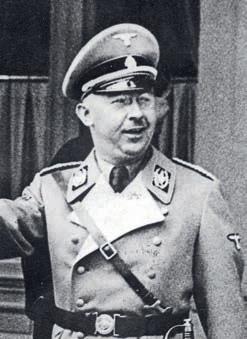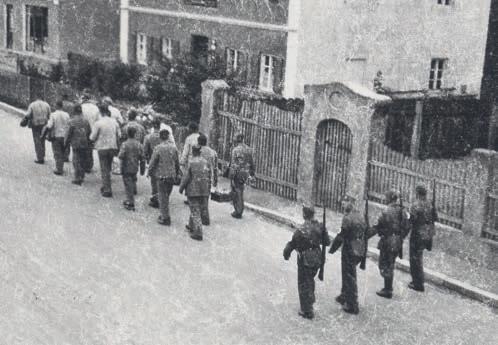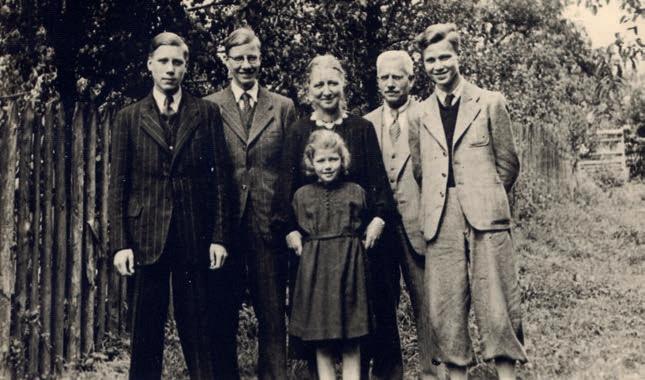
7 minute read
2.2 How did the Nazis rule Germany?
2.2 How did the Nazis rule Germany?
Once in power, the Nazis seized opportunities to take control of Germany. In March 1933, the Enabling Act was passed, which gave Hitler the sole power to make laws. In July 1933, all other political parties were banned and Germany became a one-party state. After the death of Germany’s president Hindenburg in 1934, Hitler ruled as a dictator. As the diagram below shows, the Nazis attempted to control all aspects of people’s lives.
Legal system: The Nazis took control of the legal system and the courts. Only pro-Nazi judges were appointed.
Schools: Teachers were forced to promote Nazi ideas (e.g. students were told Jews were a threat to the ‘Aryan’ or ‘master race’).
Terror: Germany became a police state. Nazi officials had the power to attack, spy on and arrest people without explanation. Führer (Leader): All Germans were expected to be loyal to Hitler. Political opposition was banned. Propaganda: Nazi ideas were powerfully communicated through rallies, speeches, films and posters.
Family life: The Nazis pressured women to marry, stay at home and have children. Men were expected to work and join the army.
Censorship: Newspapers and radio stations were taken over by the Nazis. All art, books and plays were checked before they could be produced.
Religion: The influence of the Church was controlled. Church leaders were expected to support the Nazis and their ideas. Youth groups: Non-Nazi youth groups were banned. Young people were taught to be loyal Nazis. While boys were prepared for the military, girls were prepared for motherhood. Economy: All businesses were expected to work for the success of Germany and accept Nazi controls. Trade unions were banned.
Figure 2.4 How the Nazis controlled Germany.
Activity
Pick three of the methods of control in the diagram. Explain how each of these would have helped the Nazis to rule over the German people. Think about
Why do you think the Nazis were keen to gain the support of young people? How might this have helped them to keep control in Germany?
UNIT 2
Nazi Germany 1933–39
Violence and the police state
During the 1920s, the Nazis used violence against their opponents (people who disagreed with Nazi ideas). After taking power in January 1933, the violence increased as the Nazis tried to remove all opposition. Two Nazi organisations were particularly important in the police state: the SS and the Gestapo. From 1929 to 1945, the SS (Schutzstaffel) was led by Heinrich Himmler. It was a ruthless organisation responsible for crushing opposition to the Nazis. The SS ran the concentration camps and attacked Jews and other victim groups. From 1934, the Gestapo was led by Reinhard Heydrich. The Gestapo encouraged people to spy on one another and report anyone who said or did things against the Nazis. Many Germans were terrified of the Gestapo because people could be arrested and sent to concentration camps based on rumours and without trial or explanation. New evidence shows that in some places in Germany as many as 80 per cent of the investigations carried out by the Gestapo started because of information voluntarily given by German people.
Heinrich Himmler, one of Hitler’s closest and most trusted leaders, was Head of Police, the SS and the concentration camp system. After Hitler, he was the most powerful man in Germany. He was obsessed with Nazi racial ideas. He played a leading role in the ‘Final Solution’, the plan to murder all the Jews of Europe. In 1931, Reinhard Heydrich became the leader of the Security Service of the SS (SD). Its purpose was to spy on and root out Nazi enemies in Germany and abroad. In 1934, he also became the leader of the Gestapo. In 1939, Heydrich became chief of the Reich Security Main Office which was responsible for the Nazi plan to murder all Jews during the Second World War. He was a ruthless and brutal leader. He worked closely with his superior officer, Heinrich Himmler.

Think about
Are you surprised that the German people willingly gave information about each other to the Gestapo? Why might people have done this?

Concentration camps
In 1933, approximately 200,000 political opponents, mainly communists, were arrested because the Nazis saw them as a threat to their power. The Nazis had to quickly find places to imprison all these victims, so warehouses, factories, bars, hotels, castles and sports grounds were used. In the months and years that followed, the Nazis arrested hundreds of thousands of people who, they claimed, were enemies of Germany. Increasingly, these people were imprisoned in specially built concentration camps. Between 1933 and 1945, the Nazis established 25 concentration camps with 1,100 smaller camps attached to them. On 22 March 1933, the first concentration camp opened near a town named Dachau, close to Munich. Murder was rare and most people were allowed to leave the camps after a period of time. But in all concentration camps living conditions were harsh, and beatings, humiliation, torture and forced labour were common. Nazi guards were widely known for their brutality.
2.2 How did the Nazis rule Germany?
Figure 2.5 Secret photograph of Dachau prisoners marching through town (1933/34).

Think about
Concentration camps in Germany were not hidden. What does Figure 2.5 tell us about what German people knew about camps? Why might someone have taken this image of camp prisoners in secret?
FACTS AND STATISTICS
Early concentration camps
l They became a place where key political opponents like communists, could be removed from German society. l As the camps were not hidden, they spread a climate of fear and terror across the country and discouraged people from challenging Nazi ideas and actions. l At this time the majority of concentration camp prisoners were not Jews. Yet it is estimated that in 1933, five per cent of the prisoner population were Jewish.
This means that Jewish people were five times more likely to be imprisoned in
Nazi Germany than non-Jews.
UNIT 2
Nazi Germany 1933–39
How far did the German people support the Nazis?
The Nazis clearly used violence and terror to try to control Germany. But most historians agree that it is too simple to say the German people were ‘forced’ to support the Nazis because they were afraid. In fact, during the 1930s many Germans willingly supported the Nazis because they saw them as successful. For example, Hitler had promised to reduce unemployment and he succeeded. Nevertheless, there was a small number of people and organisations who did oppose the Nazis, though this became an increasingly difficult and dangerous thing to do.
Melita Maschmann
A teenager when Hitler came to power, Melita Maschmann joined a Nazi youth organisation. She spied for the Gestapo and gave them information about the family of her Jewish friend, Marianne Schweitzer. As a result, Marianne’s elder sister was arrested and sent to a concentration camp. In 1963, Melita Maschmann published her memoirs about her support for the Nazis.
Source 2.1
Imagine all the families living in Berlin having scarcely enough dry bread to eat ... I believed the [Nazis] when they promised to do away with unemployment … I believed them when they said they would reunite Germany, which had split into more than forty political parties, and overcome the consequences of the Treaty of Versailles. Melita Maschmann, a German teenager
The Edelweiss Pirates
The Edelweiss Pirates were groups of young Germans who were opposed to the Nazis. They refused to behave as the Nazis wanted them to. Groups would go camping, sing anti-Nazi songs, fight with Nazi youth groups and during the war became involved in resistance activity. To begin with, their members were given warnings or were arrested but later, by the 1940s, they were sent to concentration camps. Some were even executed.
Source 2.2
Hitler’s power may lay us low, And keep us locked in chains, But we will smash the chains one day. We’ll be free again.
An Edelweiss Pirates song

Figure 2.6 A group of Edelweiss Pirates posing by a lake, 1939/1940.
2.2 How did the Nazis rule Germany?
Source 2.3

The opening of a new motorway in 1937. Projects like this were used to create jobs. By 1936, unemployment was no longer a problem and, for many Germans, the future looked bright.
Activity
Did everyone support the Nazis? Explain your answer. Use the sources and case studies on pages 28–29 to help you. Source 2.4









